Background: Several (ICMs) are available to enable the diagnosis and monitoring of arrhythmias. Clinicians are faced with different ICM options and must balance the workload associated with episode review alongside device performance and ensuring receipt of clinically actionable data.
Objective: To compare in-time physician-adjudicated performance and clinical actionability of ICMs from different manufacturers that are currently in use at a single-centre.
Methods: This is a retrospective analysis assessing the percentage of appropriate and inappropriate device-triggered episodes from three different ICMs (LUX-Dx, Boston Scientific; Confirm-Rx, Abbott; LINQ, Medtronic). Patients with an ICM were randomly selected from a 6-month period at a single centre (Worcestershire Acute NHS Trust, UK) and were matched using the reasons for monitoring of palpitations or syncope. Episodes were adjudicated at the time of alert by the reviewing physician. Remote reprogramming rates and clinical actions taken in response to the data are also described.
Results: Data from 30 patients were included and equally distributed among the 3 devices (n=10 LUX-Dx; n=10 Confirm-Rx; n=10 LINQ). Within each group, 2 individuals were followed for palpitations and the other 8 were followed for syncope. Over the 6-month timeframe, 65 episodes were assessed for LUX-Dx, 64 (98%) of these were ‘appropriate’ and only 1 was ‘inappropriate.’ These data supported clinical actions for 50% of the patients which included an EP study, SVT ablation, PPM referral (n=2), and CRT-P implant. Twenty-seven episodes from Confirm-Rx were assessed, 3 (11%) were ‘appropriate,’ 24 were ‘inappropriate,’ and one patient was referred for PPM. Eighteen episodes from LINQ were assessed, 12(67%) were ‘appropriate,’ 6 were ‘inappropriate’ and one patient received a PPM.
Conclusions: Although the LUX-Dx ICM had the highest number of episodes to review, it also had the highest percentage of appropriate episodes and the most clinically actionable data. ❑
Figure 1: Number of inappropriate episodes















